

Activism and Capital-A Architecture Are Alive at the AIA
by Tony P. Wrenn, Hon. AIA
In the 1970s and ’80s, the 120-year debate continued
over who architects are and what they and their professional
association should do. Among the answers that emerged: enhance the
knowledge and talent base to create architecture of the highest
quality, recognize architectural achievement past and present, and
hold it up for the edification of the profession and public
alike.
In the middle of the 1970s, as architects debated whether their
discussions of the profession were self-serving or of benefit to
society, AIA President John M. McGinty, FAIA, noted:
“There is another distinguishing hallmark of
professionalism—the scale upon which the judgments must be
made. And that is a primary allegiance to the discipline imposed by
the prior body of knowledge which circumscribes the profession.
This means a lawyer acts on knowledge of the law; it means a doctor
renders judgments for the good of his patient based on medical
science; and it means an architect places the welfare of his
society and his client ahead of his own when called upon to do so
by the discipline of the art and science of architecture …
That is a lot of baggage we’re carrying on our shoulders. It
implies not only honesty, but selflessness and even more
terrifying, competence.”
In a search for competence, the AIA reorganized its professional
interest committees in the 1970s—which till then were filled
by appointment only—and broadened them to allow all AIA
members, students, and libraries access to their publications,
conferences, and discussions. The Intern-Architect Development
Program (IDP) began, after a period of testing with some 60 firms
in three states proved the program’s value in providing
professional advice, guidance in important areas of knowledge and
skill, and development of a measurement system and educational
materials. Simultaneously, the Institute began developing a
Continuing Education Network.
As orders for AIA documents, widely used throughout the
construction industry, topped more than a million in 1977, updating
of documents continued, along with a complete revision of Chapter
13 of The Architect’s Handbook of Professional Practice on
General Conditions of the Contract for Construction and a
number of other documents. Distribution by components was
authorized, and 28 signed on to begin distribution at mid-year
1978.
New ways of working and thinking
Technological changes continued, as, as illustrated in the
San Diego 1977 Convention proceedings: “keynote speakers
preached from an elevated ‘cherry picker,’ 20 feet below
convention-goers were entertained and informed by futuristic
‘television walls,’ computerized video displays,
mini-theaters, color-coded exhibits, and an electronic message
signboard reporting daily convention events.”
In Washington, there was still unfinished business, as Congress
seemed bent on extending the West Front of the U.S. Capitol.
“Skillful AIA lobbying and expert advice convinced Congress to
delay funding ... pending further study.” The AIA received
national attention in newspapers and magazines across the country
for its efforts to insure retention of the West Front, avoiding its
destruction and coverup by new work, such as had occurred on the
East Front. Ultimately, the AIA won half its battle, for though the
East Front was extended and covered, the West Front and the Capitol
terraces have been restored. The Mall view of the building still
evidences the quality work of Bulfinch, Latrobe, and Walter.
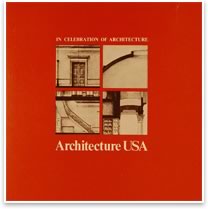 Nationally,
seven Regional/Urban Design Assistance Teams dispatched during the
year to different communities worried about urban decline.
Preservation, as with the Capitol’s West Front, was
increasingly seen as an option to the widespread demolition that
urban-renewal programs had spawned. “Recycled buildings,”
McGinty said, “can possess a warmth, a scale, a touch of
humanity that is difficult to achieve in new structures. Rebuilt
inner cities can provide convenience, maturity, and relationship to
neighbors and people, and a variety of users that is seldom found
in new suburbs.”
Nationally,
seven Regional/Urban Design Assistance Teams dispatched during the
year to different communities worried about urban decline.
Preservation, as with the Capitol’s West Front, was
increasingly seen as an option to the widespread demolition that
urban-renewal programs had spawned. “Recycled buildings,”
McGinty said, “can possess a warmth, a scale, a touch of
humanity that is difficult to achieve in new structures. Rebuilt
inner cities can provide convenience, maturity, and relationship to
neighbors and people, and a variety of users that is seldom found
in new suburbs.”
Presidents of the New Zealand, Canada, Australia, and British
architectural societies addressed the AIA 1978 Convention,
suggesting an international approach to solving the problems and
promise of architectural practice. That same year, Louis de Moll, a
Fellow of the Institute, was elected president of the International
Union of Architects (UIA), the first American to head the worldwide
organization, established in 1948 and representing some 300,000
architects around the world.
Elevating architects nationally
Still, as architects discussed intangibles, many worried
about their own financial security. AIA President Elmer Botsai,
FAIA, noted: “I know there are some architects who see
profitability as the big goal—and I feel sorry for them. They
should have become dentists.” He suggested concentrating on
education and design rather than the dollar, nonetheless advising
that entry-level architects be paid decent salaries. He noted
“it is shocking that the best way for an architectural student
to increase his future salary is to flunk design and switch to
engineering.” Botsai suggested elevating the AIA Honor Awards
program to presentation at an “elegant black-tie dinner”
and pushing publicity as a means of emphasizing design.
The AIA found other ways to publicize architects nationally,
including cooperation programs with the U.S. Postal Service, which
introduced four stamps, titled “Architecture USA,” with
first-day ceremonies at a special modular post office set up at the
1979 AIA convention in Kansas City. Featuring four historic
buildings, the stamps underscored not just good design but
preservation of that design. The stamp program continued over the
next three years, with a different four buildings each year,
culminating in 1982, the AIA 125th anniversary, with four buildings
by AIA Gold Medalists: Fallingwater, the Illinois Institute of
Technology, the Gropius House, and Dulles International
Airport.
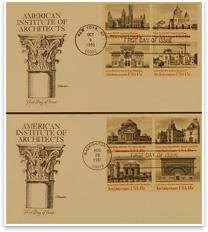 In Washington,
D.C., the AIA financed banners proclaiming “Buildings
Reborn” to be flown on 40 successfully recycled District
buildings. At the same time an exhibit titled “Buildings
Reborn: New Uses, Old Places,” at the Smithsonian’s
Renwick Gallery featured a sampling of the buildings. A brochure
with map pinpointing the buildings urged walkers to have a
look.
In Washington,
D.C., the AIA financed banners proclaiming “Buildings
Reborn” to be flown on 40 successfully recycled District
buildings. At the same time an exhibit titled “Buildings
Reborn: New Uses, Old Places,” at the Smithsonian’s
Renwick Gallery featured a sampling of the buildings. A brochure
with map pinpointing the buildings urged walkers to have a
look.
As energy conservation studies continued, the AIA completed
retrofitting of its headquarters building in early 1978 and
reported in mid-July that the work had already indicated a reduced
energy consumption of 42 percent. At that rate, the cost of the
work would be returned in energy savings in just 2.5 years.
Recognizing the contributions of others
In 1980, the AIA honored Lady Bird Johnson with an AIA
Medal and honorary membership in the Institute for “her role
in both fostering and influencing the architectural profession . .
. In particular, the jury feels that the former First Lady has been
greatly influential in the development of a sound and successful
public attitude toward the conservation and rehabilitation of the
historical architectural resources of this country.” The jury
noted her founding, in 1965, of the Committee for a More Beautiful
Capital—which had, it noted, transformed “Washington,
D.C., into a city of flowers, improved parks, and public
playgrounds.”
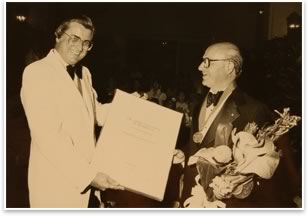 The importance
of art in architectural design was also discussed in 1980. The
Board supported including a “significant percent” of a
total architectural project budget to include art as an integral
part of the project and its surroundings. In other action, the
Board voted to support the Equal Rights Amendment (ERA) and
encouraged AIA components in unratified states to lend support to
pro-ERA activities. It also voted support for “the creation of
a national clearinghouse for architectural and archival
material,” along with the “development of regional
depositories to collect, conserve, and catalog original
architectural documents.”
The importance
of art in architectural design was also discussed in 1980. The
Board supported including a “significant percent” of a
total architectural project budget to include art as an integral
part of the project and its surroundings. In other action, the
Board voted to support the Equal Rights Amendment (ERA) and
encouraged AIA components in unratified states to lend support to
pro-ERA activities. It also voted support for “the creation of
a national clearinghouse for architectural and archival
material,” along with the “development of regional
depositories to collect, conserve, and catalog original
architectural documents.”
Visions for the profession
In the mid-May 1980 issue of the AIA Journal, the editors
asked a number of architects, educators, and critics
“What’s Next?” The answers are still worth reading.
Among them:
“Largely leaderless in the areas of land use and land
planning, the nation should be turning to the architectural
profession for far-sighted directives and technical guidance. As I
see it, there are no options. Either we, as architects, take our
place on the front line or the velocity of destructive trends will
be totally uncontrollable—and that’s when we will find
ourselves ‘on the edge of survival.’”—Nathaniel
Owings
“Architecture by itself cannot change the world. But it is
part of the world, and it is an enduring way in which change is
expressed.”—Thomas Hines
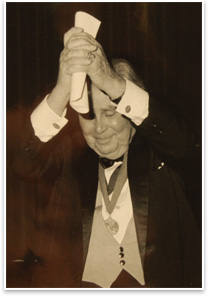 “I’d
like to see an architecture that makes sense, and does so
gracefully.”—Sarah P. Harkness, FAIA
“I’d
like to see an architecture that makes sense, and does so
gracefully.”—Sarah P. Harkness, FAIA
“Those architects who will write the legislation, design
zoning ordinances, conduct design reviews and act as client for
major institutions and agencies will have a profound
effect.”—Marvin E. Goody
“If architecture does [provide] solutions to the
interconnected esthetic, technological, social and economic
problems of the built environment … behavioral scientists,
computer managers, engineers and interior decorators [will] take
over.”—James Stewart Polshek, FAIA
“[A]rchitecture is our most . . . public. . . art form. . .
[and will] be accorded that status. . . when it is seen as an
essential part of general education.”—Marvin Filler
“The forces whose gravity are not yet fully recognized by
society or its architects are: the scarcity of nonrenewable
resources in general and energy consumption in particular;
worldwide inflation; the widening chasm between the haves and
have-nots. . . [P]rinciples used in past vernacular architecture
that respond directly to the needs of daily life and the
limitations of modest technology will re-emerge.”—Robert
B. Marquis
 Direction
’80s at 125
Direction
’80s at 125
AIA President Robert Lawrence, FAIA, would echo Marquis’
sentiments in 1982 when he told conventioneers “We don’t
want an Institute that appeals to the lowest common denominator. We
do not want to reflect a mean, a norm, an average ... The Institute
should be in the forefront of efforts to raise public awareness of
quality in our environment.”
The Direction ’80s Task Force had begun work in 1981 on a
report that would prioritize goals in five areas—body of
knowledge, education, public policy, communications, and
organization—and define appropriate roles for national, state,
and local components of the AIA. Concepts gleaned nationwide set
the agenda for a 1982 goals conference in Washington, D.C.
Delegates included representatives from all AIA regions,
government, education, and industry, along with non-architects. The
report focused internally on architects and externally on
architecture.
1982 marked the 125th anniversary of the AIA, celebrated with an
exhibit at the Octagon that recreated an architect’s office as
it might have appeared in 1857 contrasted with the actual operating
office of a Washington architect, where the drafting table was
replaced by CAD. In the AIA building, an exhibit of materials from
the AIA Archives featured items that reflected “For the
Record” the 125-year evolution of architecture from the
practice of a few to a profession. A week-long birthday party in
April featured not just the exhibits but concerts, forums, and
tours and culminated in a gala reception for invited guests,
including ambassadors, government officials, AIA officers, members,
and staff. Birthday activities brought thousands into the
courtyard, Octagon, and AIA building for an introduction to the
AIA.
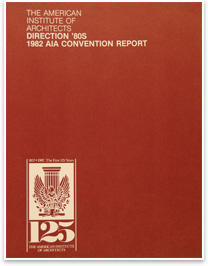 The Vietnam
Memorial
The Vietnam
Memorial
One series of events of the long hot summer of 1982 had
begun earlier when representatives of the Vietnam Veterans Memorial
Fund came to the AIA seeking guidelines for an architectural
competition. From 1,420 entries, the jury, with Paul Spreiregan as
competition adviser, selected Maya Lin, 22, a recent Yale
University architecture graduate. Some argued the
design—Modern, abstract, black, and below ground, with the
names of U.S. troops who died in Vietnam—was anti-war;
different from other Washington memorials. Veterans groups, with
the support of several nationally known figures, including
Secretary of the Interior James Watt, asked for a flagpole behind
the apex of the monument and a statue of three soldiers at the
intersection of the monument walls.
Lin steadfastly supported her design, and the AIA lent its support
“to protect the public interest and preserve design excellence
in the federal city.” In testimony before the U.S. Commission
of Fine Arts, AIA President Lawrence contrasted the “Open,
careful professional design competition process,” that chose
Lin’s design, with the “closed, politicized,
nonprofessional” process that led to the proposed
design.
“It is a new scheme in which the statue becomes the actual
memorial and the wall designed by Lin an almost incidental backdrop
supporting a flagpole,” stated the AIA position. “The
statue would be a tortured and ambiguous memorial seemingly anxious
to make a statement about the war but uncertain what the statement
should be. This is precisely the kind of thing that the competition
program sought to avoid and what the winning design, in quiet power
and dignity, totally avoided … The best design was selected.
That is the design that should come to fruition. Our veterans
deserve nothing less, and the public trust demands nothing
more.” The AIA campaigned throughout the long summer and fall
for Lin’s design, just as it had in the first quarter of the
20th century for Henry Bacon’s design for the Lincoln Memorial
less than 150 yards away.
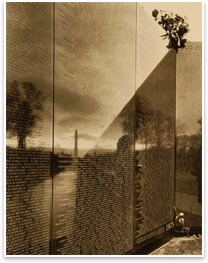 Ultimately the
Commission of Fine Arts noted that the Lin design articulated no
entry point and proposed that the flag and sculpture be part of an
entrance removed from the original design, which the AIA supported
“so that this country’s memorial to those who served in
Vietnam can be dedicated this November 11 as originally
scheduled.”
Ultimately the
Commission of Fine Arts noted that the Lin design articulated no
entry point and proposed that the flag and sculpture be part of an
entrance removed from the original design, which the AIA supported
“so that this country’s memorial to those who served in
Vietnam can be dedicated this November 11 as originally
scheduled.”
The Memorial was dedicated and has become the most visited site in
Washington. Lin’s design is breathtaking in its beauty and
emotional impact. Still, notes Raymond Rhinehart, Hon. AIA, who was
engaged in the AIA’s fight for Lin’s design, “the
controversy ... simmers on; new figures are added to the sculpture
group, the now-approved underground visitor center ... It
won’t end probably even after the last veteran dies. The hurt
is that profound, and the scar that deep. But the memorial also
endures.”
Celebrating the old and ringing in the new
In 1983, the Institute, the Library of Congress, and the National
Park Service celebrated the 50th Anniversary of the Historic
American Buildings Survey (HABS). Operated under a tripartite
agreement, HABS started as a Depression-era program to provide work
to unemployed architects and drafters. In its 50 years, the Survey
had recorded more than 16,000 structures and sites. “Since
1933, HABS has documented structures from all 50 states, the
District of Columbia, Puerto Rico and the Virgin Islands.
Currently, more than 40,000 measured drawings, 77,000 photographs
and 42,000 pages of written architectural and historical data are
housed in the Library of Congress and are available for public
use.” HABS continues as an active program.
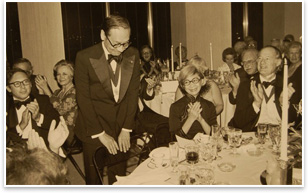 Concurrently,
a new publication, Architectural Technology magazine saw
the light of day. The new quarterly for AIA members was intended to
respond “to the need of the profession to have the best that
is being thought and written today about the science and practice
of architecture.”
Concurrently,
a new publication, Architectural Technology magazine saw
the light of day. The new quarterly for AIA members was intended to
respond “to the need of the profession to have the best that
is being thought and written today about the science and practice
of architecture.”
The same year, the AIA Journal changed its name to
Architecture. “The new name reflects the fact that
the magazine speaks for the profession, not AIA per se, and that
reporting on AIA activities, while part of its content, is by no
means the major part,” said editor Donald Canty.
It was a year of restructuring within the Institute, as well. A
Governance Task Force began “to identify the authority and
responsibility of all bodies within the Institute, including the
Board of Directors, the Executive Committee, commissions, regional
and state organizations, chapters, and national committees to study
the Institute’s responsiveness to the membership ... and to
develop a strategy for allocation ... [of] Institute resources to
encourage ... effective communication with and participation of the
membership.” The topic was, and remains, an ongoing
process.
A new dawning for architecture
With his architectural critique, A Vision of
Britain, still four years from the making, Prince Charles came
to the AIA in 1985 to hear about and discuss successful American
approaches to urban revitalization. Representatives from several
American cities with successful design control programs that had
led to urban revitalization appeared and participated. “While
no one in this room professes to have the definitive formula for
successful urban revitalization, each of us has been involved in
successful urban revitalization processes. It’s our experience
as participants in these efforts that we have to share. Perhaps
some of the elements of the process are transferable and will be of
benefit to other cities or countries,” said David N. Lewis,
AIA, RIBA, of Philadelphia. Prince Charles expressed the hope that
RIBA and the AIA would work together in studying and solving urban
problems.
At one convention session in 1985, three panel members discussed
the nature “of the architect’s contribution to the design
process.” Hugh Newell Jacobsen, FAIA, Washington, D.C., stated
that “there is a world of difference between a building and a
work of architecture ... We’re building less and less of
architecture and losing more and more to the lawyers and bankers,
who don’t know their ass from page 12. . . We are responsible
for the mess out there, not the developers. Our basic role is to
educate our clients. Our own sloth is the enemy. We were better
architects 50 years ago, because we had higher principles. . . We
don’t supervise or inspect work. We observe
it—periodically. That troubles me.” Jacobsen admitted
that saying no to an inflexible program or a difficult client was
not easy but stated flatly that “building a turkey is
worse.”
Architectural Technology was folded into
Architecture in October of 1986 to become “the most
complete magazine in the field.” Membership in the decade
1977-1986 grew from 24,000 to just under 50,000. Dues income,
“a total aggregate of basic and supplemental dues,”
received went from $4 million to more than $9 million. And the
annual budget for Institute operation rose from $8 million to $26
million.
Brendan Gill, keynote speaker at the 1986 AIA Convention noted this
growth and urged architects to take advantage of the increasing
interest in architecture. “Until recently, the profession of
architecture was not one to be entered to become rich, much less
famous. It is only within the last decade that architecture has
become fashionable . . . One is expected at dinner parties to speak
easily of contemporary icons such as Venturi and Gwathmey and Meier
and Jahn. . . Now architecture—or rather architects—are
all the rage.”
AIA President John A. Busby Jr., FAIA, followed Gill in suggesting
architects take advantage of their opportunities, ending by saying
“We proceed, we persist, we create, we change in order to give
the world beauty, shelter, home and sanctuary. The new age is
dawning, and this profession will build it. It is the greatest
challenge that we face. And with skill, commitment, and willingness
to adapt to new realities, it is going to be our greatest
triumph.”
Copyright 2005 The American Institute of Architects. All rights reserved. Home Page

